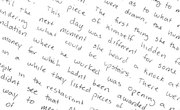The present perfect tense is used when stating an action that started in the past and is continuing on into the present. Present perfect also indicates an event that happened at an indefinite time in the past or an event that took place recently. It's expressed by using a helping verb plus the past participle which will end in "-ed" if it's a regular verb. Present perfect differs from simple past tense because it's used to describe situations with no finished time.
Contrast Finished and Unfinished Time
On the board draw two columns, label one finished time, the other unfinished time. Under finished time, list words such as yesterday, last week, last year and the year 2000. These are completed measures of time. Under unfinished time, list words such as today, this week, this year and the present year. None of these times have been completed. Students then create sentences using both the simple past -- "Last year I moved to California" -- and the present perfect -- "This year I have started taking ESL classes."
Yes/No Interview Questions
Begin this exercise with questions that will lead students to provide answers in the present perfect tense. Teacher: "Have you ever played soccer?" Student: "No, I haven't." Then break the class into pairs and have them ask each other yes/no questions. Provide cards with sample questions such as: "Have you ever broken a bone?" or "Have you ever been late for work?" Encourage the students to interview each other with their questions so the exercise will be more meaningful.
Combining Sentences
Present two sentences that can be made into one using the present perfect tense. For example, "Maria is cooking" and "Maria started to cook three hours ago" can be combined into "Maria has been cooking for three hours." Once students are comfortable combining sentences, divide them into groups and hand each group an envelope with three cards. Written on each card are two sentences that the students are instructed to make into one.
Scrambled Sentences
Begin by putting a sentence on the board. For example, "Tom has been skiing for two years." Then write the sentence again with the words scrambled. Repeat this exercise until students understand, then divide the class into groups. Hand each group an envelope with one scrambled sentence. Every time a group unscrambles a sentence, they can write the corrected sentence on the board and get a new envelope.









